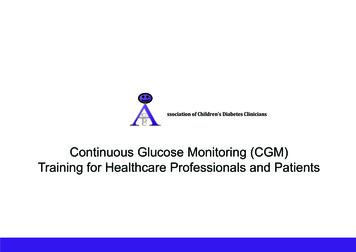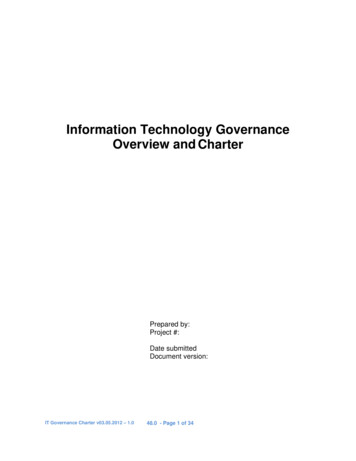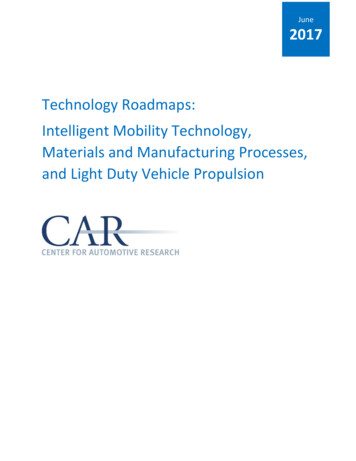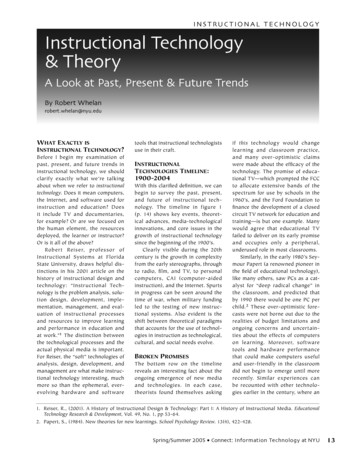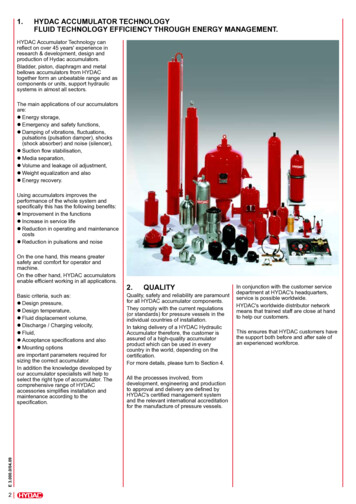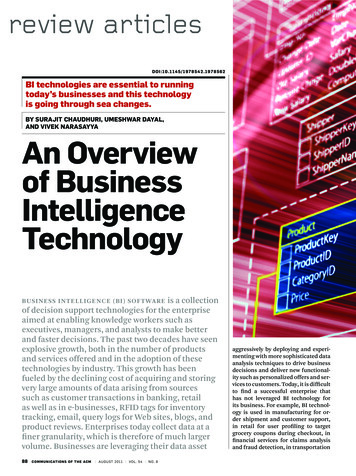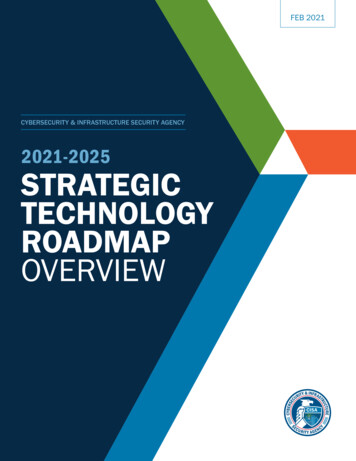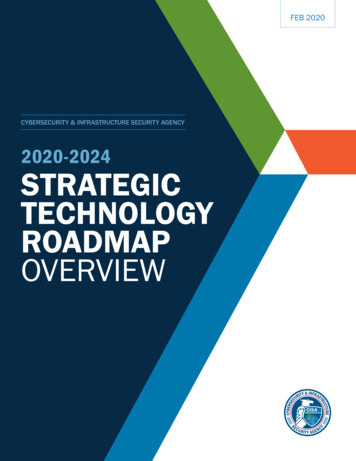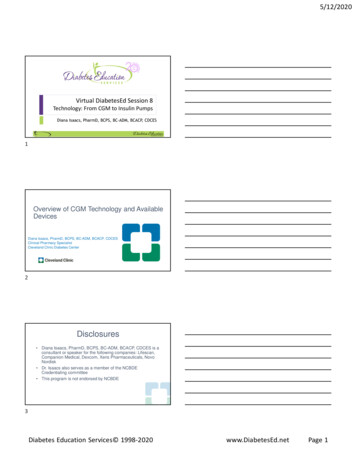
Transcription
5/12/2020Virtual DiabetesEd Session 8Technology: From CGM to Insulin PumpsDiana Isaacs, PharmD, BCPS, BC-ADM, BCACP, CDCES1Overview of CGM Technology and AvailableDevicesDiana Isaacs, PharmD, BCPS, BC-ADM, BCACP, CDCESClinical Pharmacy SpecialistCleveland Clinic Diabetes Center2Disclosures Diana Isaacs, PharmD, BCPS, BC-ADM, BCACP, CDCES is aconsultant or speaker for the following companies: Lifescan,Companion Medical, Dexcom, Xeris Pharmaceuticals, NovoNordisk Dr. Isaacs also serves as a member of the NCBDECredentialing committee This program is not endorsed by NCBDE3Diabetes Education Services 1998-2020www.DiabetesEd.netPage 1
5/12/2020Learning Objectives Describe continuous glucose monitoring(CGM) and the clinical benefits for managingdiabetes mellitus Compare and contrast the CGM devicesavailable for personal and professional use4Evolution of Glucose MonitoringModified reagentstrip for bloodglucose –Dextrostix1957First reagent stripusing glucoseoxidation reaction– Clinistix1964Portable bloodglucose meters –OneTouch1970First blood glucosemeter – AmesReflectance Meter19871999PresentDevelopment ofContinuousGlucose Monitors(CGMs)Clarke SF, Foster JR. A history of blood glucose meters and their role in self-monitoring of diabetes mellitus. Br J Biomed Sci 2012;69:83–935How Does Continuous Glucose Monitoring(CGM) Work? Measures glucose from interstitial fluid (ISF) every 1-5 minutes and recordsglucose every 5-15 minutes (up to 288 readings/day) Slight delay compared with whole blood glucose (lag time)ADCES Practice Paper. The diabetes care and education specialist role in CGM.6Diabetes Education Services 1998-2020www.DiabetesEd.netPage 2
5/12/2020SMBG vs CGM glucometer readingsUndetected hyperglycemiaUndetected hypoglycemiaSMBG, self-monitoring of blood glucose.Image created and permission to use granted by John Moorman, PharmD.7CGM Considerations Real time vs retrospective Blinded vs unblinded Sensor Transmitter Receiver/reader Warm-upCalibrationTrend arrowsFDA approved for dosingdecisionsMean absolute relativedifference (MARD)8Guideline Updates Technology section added in 2019 Ambulatory glucose profile (AGP) and time inrange discussed as glycemic targets (in additionto A1C) Real-time CGM (rtCGM) and intermittentlyscanned CGM (isCGM) are useful to lower A1Cand/or reduce hypoglycemia in adults who arenot meeting glycemic targets, have hypoglycemiaepisodes, and/or unawareness There is no “one-size-fits-all” approach totechnology use in people with diabetes CGM use requires robust and ongoing diabeteseducation, training, and support9Diabetes Education Services 1998-2020www.DiabetesEd.netPage 3
5/12/2020Types of CGMProfessionalPersonalOwned by the clinicOwned by the patientBlinded and unblinded (real-time feedback)optionsReal-time feedback or scan for feedback(flash device)Short-term use (3-14 days)Long-term useInsurance coverage for most people withtype 1 or type 2 diabetesInsurance coverage more focused on type 1diabetes or those on intensive insulinregimensNot compatible withinsulin pumpsCompatible with smartphones and insulinpumps with select devicesWright LA, Hirsch IB. Diabetes Technol Ther. 2017;19(suppl 2):S16-S26; Kruger DF, et al. Diab Educ. 2019;45(suppl 1):S3-S20.10CGM: Real-Time Data11Integrated CGM Classification New FDA classification: Integrated Continuous Glucose Monitoring (iCGM)– Class II with SpecialControls Benefits: Streamlined premarket review process Minimizes the FDA review time for new products Easily integrated with digitally connected devices Key criteria: Performance and accuracy standards are robust and stringent: %15/15 accuracy at variousglucose ranges 80% iCGM must be within 15/15% when the lab results 180mg/dL 70% iCGM must be within15/15% when the lab results 70-180mg/dL 85%, iCGM ust be within 15/15% when the lab results 70mg/dLFDA Authorizes First Fully Interoperable Continuous Glucose Monitoring System, Streamlines Review Pathway for Similar Devices. us-glucose-monitoring-system-streamlines-review. Accessed November 18, 2019.12Diabetes Education Services 1998-2020www.DiabetesEd.netPage 4
5/12/2020Professional CGM OptionsMedtroniciPro2Abbott FreeStyleLibre ProDexcom G6 Pro13Professional CGM ComparisonBlinded vs unblindedMaximum wear time ofsensorCalibrationDownloading reportsCare between transmitter useAlarms for high/low glucosealertsInterfering substancesiPro2Blinded6 daysG6 ProBoth10 daysLibreProBlinded14 days3-4 per dayCareLinkClean and disinfecttransmitterNoNoneCLARITYDisposable 1-time useNoneLibreViewDisposable 1-time useYesNoAcetaminophenHydroxyureaSalicylic acid and high-dosevitamin CADCES Practice Paper. The diabetes care and education specialist role in CGM.Product websites14Personal CGM OptionsAbbott FreeStyle Libre FlashDexcom G6Dexcom G5Medtronic GuardianConnect and Guardian 3Senseonics Eversense15Diabetes Education Services 1998-2020www.DiabetesEd.netPage 5
5/12/2020Dexcom G6 10-day wear2-hour warm-upNo calibrations required: optional1-touch inserter, must attach transmitterReusable transmitter: 3 monthsFDA approved for dosing decisionsChoice of receiver or cell phone (Android or iPhone)High, low, predictive alertsNo drug interferenceCLARITY app offers user insightsIntegration with Tandem X2 insulin pumpiCGMDexcom G6 CGM system. Available at:. dexcom.com/g6-cgm-system16Guardian Connect & Guardian 37-day wearUp to 2-hour warm-upNot FDA-approved for dosing decisionsCalibrations required 2 times/dayAcetaminophen interferenceGuardian Connect compatible works with iPhone or IpadGuardian 3 compatible with 670G pumpRequires extra steps of attaching transmitter and taping Charge every 7 days, transmitter lasts for 1 year Guardian Connect App Powered by IBM Watson via Sugar.IQ diabetes assistant to determine likelihood ofhypoglycemia (predictive lows up to 4 hours in advance) Provides predictive glycemic patterns based on user input Guardian Connect CGM. Available at:. ntinuous-glucose-monitoring-system17Freestyle Libre Flash 14-day wear 1-hour warm-up FDA approved for insulin dosing, except for the first 12 hours after insertion May use phone to scan with LibreLink Must scan every 8 hours to avoid data gaps Aspirin and high-dose vitamin C interference 1 press inserter, disposable transmitter included with sensor No real-time alertsFreeStyle Libre. Available at:freestylelibre.us/index.html18Diabetes Education Services 1998-2020www.DiabetesEd.netPage 6
5/12/2020Eversense Implantable CGM Sensor lasts 90 days (no new starts) FDA submission for 180 day sensor MRI safe when outer transmitter is removed FDA approved for insulin dosing False elevations with IV mannitol and sorbitol 24-hour warm-up, dressing stays on 2 days after insertion Requires 2 calibrations/day If no calibration after 16 hours, will shut off Slim rechargeable smart transmitter taped above sensor Communicates to iPhone or Android app (no separate receiver) On-body vibe alertsEversense. Available at: eversensediabetes.com19Personal CGM ComparisonInsulin pumpintegrationReceiverMaximum wear timeG6T:SlimLibre FlashNoGuardian Connect or Guardian 3EversenseMedtronic 670G, 630G (Guardian 3) NoiPhone, Android orreceiver10 daysiPhone, Android, orreader14 daysiPhone (Guardian Connect)7 days90 days1 hour0Up to 2 hours2-4 occasional diagnostic24 hours2Eversense datamanagement systemYesWarm-up time2 hoursCalibrations0required/dayDownloading software Dexcom CLARITYFDA approved fordosingData sharingAlarms for high/lowFDA approved ages(years)LibreViewCareLinkYesYesNoYesYesOver 2YesNoOver 18YesYesGuardian 3: Over 2Guardian Connect: Over 7iPhone, AndroidYesYesOver 18Product labels20Which of the following CGM devices providesreal time alerts and can be worn up to 10 days?A. Dexcom G6B. Freestyle LibreC. EversenseD. Guardian Connect21Diabetes Education Services 1998-2020www.DiabetesEd.netPage 7
5/12/2020Data Management ToolsSystemGlookoWebsiteglooko.comAssociated Mobile AppsGlookoCLARITYclarity.dexcom.comWhat it DownloadsInsulin pumps (Omnipod, Tandem),Dexcom, Eversense, many glucosemetersDexcomeversensedms.comFreeStyle LibreMedtronic insulin pump andMedtronic CGMInsulin pumps (Medtronic, Tandem,Omnipod), FreeStyle Libre, Dexcom,Guardian Connect, many glucosemetersEversenseDexcom G5, G6, Clarity,Dexcom Followlibreview.comLibreLink, LibreLinkUpcarelink.medtronic.com Guardian Connect, Carelink,Sugar IQ Diabetes Assistanttidepool.orgTidepool MobileLibreViewCarelinkTidepoolEversense DataManagementSystemEversense22The Evidence23Increased BG Monitoring Leads to LowerA1C in T1DMType1 DMExchangeN 20,555Miller KM et al. Diabetes Care. 2013;36:2009-201424Diabetes Education Services 1998-2020www.DiabetesEd.netPage 8
5/12/2020DIAMOND Trial: T1DM MDIA1C Treatment Group DifferencesP .001P .001Mean A1c%BaselineWeek 12Week 24A1C: 0.6% difference at 24 weeks(N 158)Beck RW et al., JAMA. 2017;317(4):371-378.25DIAMOND Trial-T2DM MDIA1c Treatment Group DifferencesP .02P .005BaselineBeck RW et al. Ann Intern Med. 2017 Sep 19;167(6):365-37Week 24-Week 12A1C: 0.3% difference at 24 weeks(N 158)26DIAMOND Trial-T2DM MDIGreater Benefit with Higher Baseline A1CBaselineHbA1cChange in HbA1c From BaselineDifferenceP valueCGM GroupUsual Care Group 7.5%-0.9% (n 79)-0.5% (n 79)0.4%0.02 8.0%-0.9% (n 63)-0.6% (n 57)0.3%0.05 8.5%-1.1% (n 39 )-0.7% (n 39)0.4%0.02 9.0%-1.4% (n 17)-0.7% (n 21)0.7%0.04Beck RW et al. Ann Intern Med. 2017 Sep 19;167(6):365-3727Diabetes Education Services 1998-2020www.DiabetesEd.netPage 9
5/12/2020Flash CGM in T1DM Prospective, randomized controlled trial 241 participants with type 1 diabetes and A1C 7.5%, mean A1C 6.7%38% reduction in hypoglycemia19% reduction in hyperglycemiaDaysBolinder, et al. Lancet 2016; 388: 2254–6328Flash CGM in T2DM and MDI Prospective, randomized, controlled trial, 6 months Participants with type 2 diabetes and MDI (N 224) Primary outcome: change in A1C Secondary outcomes compared to usual care Hypoglycemia reduced by 43% (BG 70 mg/dL) and 53% (BG 55 mg/dL )Nocturnal hypoglycemia reduced by 54%Glucose variability reducedIncreased treatment satisfactionHaak et al. Diabetes Ther 2016;8:55–7329What has the greatest impact on A1Clowering for people with type 1 diabetes?A. Insulin pumpB. CGMC. Mobile apps for carb counting3030Diabetes Education Services 1998-2020www.DiabetesEd.netPage 10
5/12/2020COMISAIR Study Prospective, non-randomized trial with T1D (N 94) rtCGM MDI vs rtCGM CSII vs SMBG MDI vs SMBG CSII Primary endpoint: A1C, Baseline 8.2% Other endpoints: hypoglycemia, time in range, hyperglycemia CGM groups A1C: 6.9% (pump), 7.0% (MDI) Non CGM groups A1C: 7.7% (pump), 8.0% (MDI)Soupal J et al. Diabetes Care 2019 Sep; dc190888.31Downloading CGM Data32How does exercise affect glucose levels?A. IncreaseB. DecreaseC. No effectD. I have no idea3333Diabetes Education Services 1998-2020www.DiabetesEd.netPage 11
5/12/2020At least 42 factors affect glucose!Food1.2.3.4.5.6.7.8.9. Carbohydratequantity Carbohydrate type Fat Protein Caffeine Alcohol Mealtiming Dehydration? PersonalmicrobiomeActivityMedication10. Dose11. Timing12. Interactions13. Steroidadministration14. Niacin(vitamin B3)15. Lightexercise16. High/moderateexercise17. Level offitness/training18. Time of day19. Food andinsulin 1.32.33. Insufficient sleep Stress and illness Recent hypoglycemia During-sleep bloodsugars Dawn phenomenon Infusion set issues Scar tissue andlipodystrophy Intramuscularinsulin delivery Allergies A higher glucose level Menstruation Puberty Celiac disease SmokingEnvironmental34. Expiredinsulin35. InaccurateBG reading36. Outsidetemperature37. Sunburn38. ? AltitudeBehavioraland decisionmaking39. Frequency ofglucose checks40. Defaultoptions andchoices41. Decisionmaking biases42. Familyrelationships andsocial pressuresAdapted from Brown A. DiaTribe Learn: Making sense of diabetes.diatribe.org/42factors34CGM Data: Key MetricsCGM MetricStandardized visualization of dataMean glucoseHypoglycemiaVery low/clinically significant hypoglycemiaHyperglycemiaVery high/clinically significant hyperglycemiaTime in rangeGlycemic variability (coefficient of variation)Glucose management indicator (GMI)Recommended data sufficiencyMeasureAmbulatory glucose profile (AGP)Calculated 70 mg/dL 54 mg/dL 180 mg/dL 250 mg/dL70-180 mg/dLStandard deviation/mean, stable 36%CGM version of estimated A1C70% sensor use over 14 daysBattelino T, et al. Diabetes Care. 2019;42(8):1593-1603.35Time in Range Percentage of readings in range of70-180 mg/dL per unit of time for mostpatients Expressed as ‘‘% of glucose readings’’or ‘‘hours per day’’ Clinical utility: higher is better andmeans less hypoglycemia andhyperglycemia, correlates withimproved outcomes vs A1C aloneAgiostratidou G, et al. Diabetes Care. 2017;40(12):1622-1630.36Diabetes Education Services 1998-2020www.DiabetesEd.netPage 12
5/12/2020What is the goal time in range for mostadults with type 1 or 2 diabetes?A. 50%B. 70%C. 80%D. 90%37Time in Range (TIR) Goals:International ConsensusBattelino T, et al. Diabetes Care. 2019;42(8):1593-1603.38Time in Range and A1C CorrelationN 545 participantswith type 1 diabetesBeck RW, et al. J Diabetes SciTechnol. 2019;13(4):614-626.Measured TIRA1C95% 70%7.0%5.6%-8.3%80%6.5%5.2%-7.8%39Diabetes Education Services 1998-2020www.DiabetesEd.netPage 13
5/12/2020Ambulatory Glucose Profile (AGP)40Spaghetti GraphImage obtained from Dexcom CLARITY report.41Snapshot to Assess HypoglycemiaImage obtained from LibreView report.42Diabetes Education Services 1998-2020www.DiabetesEd.netPage 14
5/12/2020ComparingDay to DayImage obtained from LibreView report.43CGM Counseling Points Important to check glucose when Avoid with MRI, CT, diathermyindicated Exception: Eversense implantable, Symptoms do not match sensor value During warm-up period When making dosing decisions for selecttransmitter should be removed Not FDA approveddevices Pregnancy, dialysis, critically ill If people choose to use, it is importantthey know it is off-label and discusspotential risks Sensors are waterproof Showering, bathing, swimming OK Preferable to avoid hot tubs, saunas44CGM Device e ofDownloadNonadjunctiveIndicationInsulin PumpCompatibleReceiverFunctionalityAlarms forHigh/LowData SharingCalibrations***Individual Preferences***Kruger DF, et al. The Diabetes Educator. 2019;45(suppl 1):S3-S20.45Diabetes Education Services 1998-2020www.DiabetesEd.netPage 15
5/12/2020Troubleshooting Site Adhesivenesshttps://diatribe.org/CGMtips46Patient Cases47Meet Derek 48-year-old man, type 2 diabetes x 10 years, maxed out on metformin, GLP-1 agonist, SGLT2inhibitor, sulfonylurea A1C 9%-9.5% for 12 months, FBG and pre-dinner SMBG 150 mg/dL He agreed to wear a professional CGM for 7 daysDerek was shocked by whathappened betweenbreakfast and dinner; heagreed to start insulin.48Diabetes Education Services 1998-2020www.DiabetesEd.netPage 16
5/12/2020Meet Adriane 47 year old with T1DM A1C 6.4% Insulin glargine 16 units BID Insulin aspart: 1 unit for10 gramsCHO Correction factor: 1:2549Adriane’s AGP What do you notice? Is Adriane meetingtargets? What questions to ask?50Meet Jane 56-year-old woman with type 2 diabetes x 5 years Meds: Metformin 1000 mg BID, Insulin glargine 20 units daily, insulin lispro 5units TID a.c. ss#1 (1 unit for every 50 over 150)7.3%glucosemanagementindicator51Diabetes Education Services 1998-2020www.DiabetesEd.netPage 17
5/12/2020Exploring Day by Day Ask about the bestday first Then explore areasof lows Ask permission todiscuss highs52The DCES Role Ask Jane how she takes her insulin Missed doses, administration times in relation to meals Discuss typical daily routine, meal schedule, physical activity Other factors that can impact BG: stress, sleep Use information above to come up with individualized self-managementrecommendations Eat consistently with insulin lispro to avoid hypoglycemia, take 30 before the meal Reduce higher carbohydrate foods like potato chips Consider smart pen to track insulin doses53Conclusion There are several CGM options, and the DCES can help patientsselect the best device for their individual needs There are many benefits to CGM including reduction inhypoglycemia and reduced A1C CGM data can be used to discussion diabetes self-management withthe person with diabetes and help to make meaningful changes54Diabetes Education Services 1998-2020www.DiabetesEd.netPage 18
5/12/2020Additional CGM ResourcesDiabetes Advanced Network Access (DANAtech)danatech.orgAssociation of Diabetes Care and cialists (ADCES) glucose monitoring resources blood-glucosediaTribediatribe.orgSenseonics Eversenseeversensediabetes.comMedtronic Guardian ctDexcom G6dexcom.com/g6-cgm-systemAbbott FreeStyle Librefreestylelibre.us55Diabetes Technology:Insulin PumpsDiana Isaacs, PharmD, BCPS, BC-ADM, BCACP CDCESClinical Pharmacy Specialist/CGM Program CoordinatorCleveland Clinic Diabetes Center56Disclosures Diana Isaacs, PharmD, BCPS, BC-ADM, BCACP, CDCES is aconsultant or speaker for the following companies: Lifescan,Companion Medical, Dexcom, Xeris Pharmaceuticals, NovoNordisk Dr. Isaacs also serves as a member of the NCBDECredentialing committee This program is not endorsed by NCBDE57Diabetes Education Services 1998-2020www.DiabetesEd.netPage 19
5/12/2020Learning Objectives Describe critical teaching content before starting insulinpump therapy Describe appropriate candidates for insulin pump therapy State important safety measures to prevent hyperglycemiccrises crises. Explain the currently available and future pipeline of insulinpumps List inpatient considerations for insulin pump therapy andCGMs58How a Pump Delivers InsulinNormal InsulinSecretionInsulinInsulin PumpDeliveryTimeSchematic representation only.59Pump Basics1. Pumps use rapid-acting insulin Minimizes insulin variability2. Pumps deliver insulin in two ways Basal:- Replaces long-acting insulin- Covers hepatic glucoseproduction/maintains glycemicstability in fasting stages- Automatically delivers preciseprogrammed dose- Adjust to match diurnal variations Bolus: Covers glucose consumptionand corrects hyperglycemia3. Pumps use Bolus Calculator60Diabetes Education Services 1998-2020www.DiabetesEd.netPage 20
5/12/2020Ideal Patients MotivatedChecking BG 4 times/day or wearing CGMA1c 10%Carb countingAbility to learn pump programmingWilling to follow up regularly with health care teamCan afford the pump/suppliesCounting carb grams- Accuracy matters Following hyperglycemia treatment instructions61Onboarding a New Patient1. Pre-pump group class2. Individual CDCES visit(s) for advanced carb counting asneeded3. Pump start (2-3 hour individual CDCES visit) Pt sends BGs regularly for rate adjustments4. Advanced pumping follow-up visit with CDCES in 2-4weeks5. MD/NP follow-up in 4-6 weeksBase on Cleveland Clinic insulin pump program62Common Pump Features Bolus calculatorTemporary basal or temp targetInsulin-on-board/active insulin featureMultiple basal patternsSmall dose incrementsIntegration with CGMDesigned to work with U100 insulin4-year warranty/contract63Diabetes Education Services 1998-2020www.DiabetesEd.netPage 21
5/12/2020Extended Boluses Great for high-fat foods or gastroparesis64Safety Features Alarms for occlusion or low insulin reservoirActive insulin
Guardian Connect compatible works with iPhone or Ipad Guardian 3 compatible with 670G pump Requires extra steps of attaching transmitter and taping . CLARITY clarity.dexcom.com Dexcom G5, G6, Clarity, Dexcom Follow Dexcom Libre
